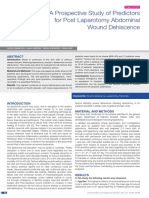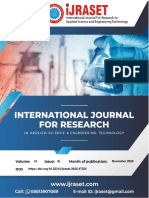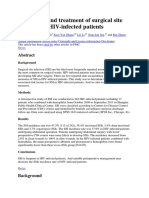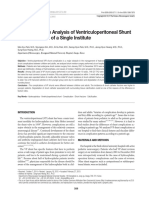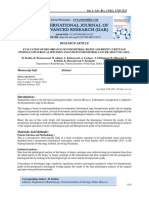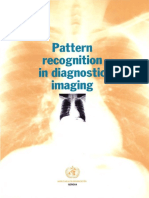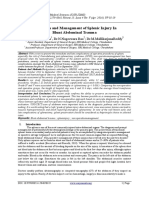Professional Documents
Culture Documents
A Clinical Study of Clavien-Dindo Classification of Postoperative Complications Following Major Abdominal Surgeries in A Tertiary Care Centre
Original Title
Copyright
Available Formats
Share this document
Did you find this document useful?
Is this content inappropriate?
Report this DocumentCopyright:
Available Formats
A Clinical Study of Clavien-Dindo Classification of Postoperative Complications Following Major Abdominal Surgeries in A Tertiary Care Centre
Copyright:
Available Formats
Volume 8, Issue 1, January – 2023 International Journal of Innovative Science and Research Technology
ISSN No:-2456-2165
A Clinical Study of Clavien-Dindo Classification
of Postoperative Complications Following Major
Abdominal Surgeries in a Tertiary Care Centre
Dr. R. ASHOK REDDY1, Dr. P. SUBASH CHANDRA2, Dr. Ch. BALAJI3, Dr. G. SREE GAYATHRI4
PROFESSOR & HOD1, ASSISTANT PROFESSOR2,3, FINAL YEAR POST GRADUATE4
DEPARTMENT OF GENERAL SURGERY GREAT EASTERN MEDICAL SCHOOL SRIKAKULAM
Abstract:- There is no surgery without any complication. III. MATERIAL & METHODS
It is every surgeon’s aim to minimize Postoperative
complications. It is therefore necessary to evaluate and Prospective, cross sectional, hospital based study in
classify the complications in an easiest possible way. patients admitted at GEMS medical college for major
Clavien – Dindo classification is a simple and acceptable abdominal surgeries that are both elective and emergency.
way to evaluate post-surgical complications in patients A total of 109 cases those who underwent major
undergoing major abdominal surgeries. abdominal surgeries from January 2021 to August 2021
have been studied.
Keywords:- Complications, Clavein-Dindo, post-operative, A detailed history was taken and patients were evaluated
major, abdominal surgeries. preoperatively based on history, associated co-morbidities
and other investigations.
I. INTRODUCTION
A. INCLUSION CRITERIA
Everysurgerycomeswithitsowncomplications. The study included all patients hospitalized to the
The surgical team continually strives to keep the general surgery department who were older than 18 and
occurrence of serious problems for patients interested in taking part.
experiencing any type of surgery at a minimum..
Frequentlythefunctionalresultsoftheoperationare B. EXCLUSION CRITERIA:
compromised bycomplications. Patients who underwent abdominal surgery earlier.
Insomecasesthepatientneverrecoverstothe preoperative Pregnancy
level of function. Surgeries for carcinomas
The significant and difficult part is the suffering borne by Immunocompromised patients
the patient who enters the hospital anticipating an Complications developed after 30 days of surgery
uneventful surgery. Those not willing to participate.
Appropriate appraisal of the surgeon's work and perhaps
advancement in the surgical field have been impeded by IV. STATISTICAL ANALYSIS OF DATA
the lack of agreement within the surgical field on the
accurate manner to report surgical complications.. Data collected was entered into excel sheets and results
Clavien-Dindo classification is simple and acceptable way were analyzed using SPSS.20 software.
in evaluating post-surgical problems in patients The distribution of the variables was determined at 67%
undergoing major abdominal surgeries. with a 20% precision and a 95% confidence interval.
II. AIMS & OBJECTIVES V. SURGERIES INCLUDED IN OUR STUDY
The aim of this study is to assess the postoperative LAPAROSCOPIC CHOLECYSTECTOMY.
complications in patients who underwent major abdominal OPEN CHOLECYSTECTOMY.
surgeries and to grade them according to Clavien-Dindo EXPLORATORY LAPAROTOMY FOR ACUTE
classification. INTESTINAL OBSTRUCTION.
To establish the usefulness of Clavien-Dindo EXPLORATORY LAPAROTOMY FOR HOLLOW
classification in postoperative assessment of abdominal VISCUS PERFORATION.
surgeries. SPLEENECTOMY.
VI. RESULTS
AGE DISTRIBUTION: The age of patients ranged from
18-68years with a mean age of 43.78years and most
patients are between 40-50years.
IJISRT23JAN297 www.ijisrt.com 1049
Volume 8, Issue 1, January – 2023 International Journal of Innovative Science and Research Technology
ISSN No:-2456-2165
50
45
40
35
30
25
20
15
10
5
0
18-28 28-38 38-48 48-58 58-68
Fig. 1: Age Distribution
males
females
Fig. 2: Sex Distribution
40
35
30
25
20
15
10
0
lap chole open chole perforation closure R&A SPLEENECTOMY
Fig. 3: Surgery Incidence
IJISRT23JAN297 www.ijisrt.com 1050
Volume 8, Issue 1, January – 2023 International Journal of Innovative Science and Research Technology
ISSN No:-2456-2165
DIABETES MELLITUS 19
HYPERTENSION 17
ANAEMIA 13
HYPOPROTINEMIA 11
JAUNDICE 4
OTHERS 6
ABSENT 39
Table 1: Co-Morbidities
POST OP FEVER 16
PROLONGED ICU STAY 23
WOUND INFECTION 11
ANAEMIA 14
ACUTE KIDNEY INJURY 13
BASAL LUNG ATELECTASIS 12
OTHERS 4
ABSENT 15
DEATH 1
Table 2: Complications
GRADES DEFINITION
1 Any deviation from normal post op course without the need for pharmacologic treatment or
surgical , endoscopic and radiological interventions
2 Requiring pharmacological treatment with drugs other than such allowed for grade 1 complication.
Blood transfusion and TPN included.
3 Requiring endoscopic , radiological or surgical intervention
3A Intervention not under GA
3B Intervention under GA
4 Life threatening complications requiring ICU management
4A Single organ dysfunction including dialysis
4B Multi organ dysfunction
5 Death of patient
Table 3: CLAVIEN-DINDO CLASSIFICATION
VII. DISCUSSION (14.6%) followed by 18-28 years(13.7%) and 58-68
years(10.09%).
As a result of the ease with which the information in our Total emergency surgeries done were 44 (40.3%)and
database may be transformed into this classification, the elective surgeries were 65(59.6%).
Clavien - Dindo categorization is unbiased and Most commonly associated co morbidity was diabetes
straightforward. (17.43%) and hypertension (15.59%) followed by anemia
It should be emphasized that only 32.1% of patients who (11.92%) and hypoproteinemia (10.09%).
used this approach had a normal post-operative course, The commonest complication was prolonged ICU stay
and 67.9% of patients experienced any variation from it. (21.1%) which was seen in patients with above mentioned
This is as a result of the study's inclusion of emergency comorbidities as they required correction of these
abdominal surgery. disorders.
The common age group of presentation was 48-58 years ( Patients with anemia preoperatively and some of them
42.2%) followed by 28-38years (19.2%) then 38-48 years postoperatively required blood transfusions putting them
in grade 2 of Clavien-Dindo classification.
IJISRT23JAN297 www.ijisrt.com 1051
Volume 8, Issue 1, January – 2023 International Journal of Innovative Science and Research Technology
ISSN No:-2456-2165
Out of the 13 patients that presented with acute kidney a single institute in central Rajasthan. Arch Int Surg.
injury 4 patients required hemodialysis postoperatively 2016, 6:170-175. 10.4103/2278-9596.202365.
putting them into grade 4A of classification and the rest [7.] Bolliger M, Kroehnert JA, Molineus F, Kandioler D,
were treated conservatively. Schindl M, Riss P: Experiences with the standardized
Out of 12 patients with basal lung atelectasis as classification of surgical complications (Clavien-
complication 2 patients required intubation and Dindo) in general surgery patients. Eur Surg. 2018,
mechanical ventilation putting them into grade 3B. 50:256-261. 10.1007/s10353-018-0551-z.
Grade 5 complication was noted in one case that was [8.] Lian B, Chen J, Li Z, Ji G, Wang S, Zhao Q, Li M.
brought with features of peritonitis, septic shock and acute Risk Factors and Clavien–Dindo Classification of
kidney injury. Postoperative Complications After Laparoscopic and
Patient was operated on emergency basis and was Open Gastrectomies for Gastric Cancer: A Single-
monitored in ICU. Patient was declared dead on second Center, Large Sample, Retrospective Cohort Study.
post-operative day due to multi organ failure. Cancer Manag Res. 2020;12:12029-12039
Mean ICU stay of our patients was noted to be 6.3+ 2.9 [9.] https://doi.org/10.2147/CMAR.S275621
days.
Patients with complications of grades 2 and 3 required
longer stays in the intensive care unit (ICU), confirming
the value of the Clavien-Dindo classification in
identifying problems of various intensities.
VIII. CONCLUSION
To sum up, the Clavien-Dindo classification offers a
straightforward and objective technique to record all
problems in patients having major abdominal procedures.
This grading method successfully separates the severity of
complications from a typical post-operative course and
enables the surgeon to make that distinction.
Comparing the varied complications between various
operations is also of special interest.
REFERENCES
[1.] Riccardo C, Claudio R, Raffaele P, Lucia C, Marielda
D, Giovanni T, et. al. Assessment of complications
according to the Clavien-Dindo classification after
distal pancreatectomy. J Pancreas. 2011;12(2):125-
30.
[2.] Vignesh R, Raza M. Assessment of postoperative
complications in elective major abdominal surgeries
by clavein-dindo classification system in the Indian
hospital setting. Paripex Indian J Res. 2016;5:6-10.
[3.] Clavein PA, Barkun J, Oliveira MLd, Vauthey JN,
Dindo D, Schulick RD, et al. The Clavien-Dindo
classification of surgical complications: five-year
experience. Ann Surg. 2009;250(2):187–196.
Available from:
https://doi.org/10.1097/sla.0b013e3181b13ca2.
[4.] Manekk R S, Gharde P, Gattani R, et al. (May 13,
2022) Surgical Complications and Its Grading: A
Literature Review. Cureus 14(5): e24963.
doi:10.7759/cureus.24963.
[5.] Tevis SE, Kennedy GD: Postoperative complications
and implications on patient-centered outcomes. J Surg
Res. 2013, 181:106-113. 10.1016/j.jss.2013.01.032.
[6.] Singh A, Porwal R, Gupta HP, Sharma AK, Kumawat
G: Determinants of outcome in gastrointestinal
perforations with special reference to Clavien-Dindo
classification of surgical complications: experience of
IJISRT23JAN297 www.ijisrt.com 1052
You might also like
- NURS 366 Exam 1 Study Guide and RubricDocument7 pagesNURS 366 Exam 1 Study Guide and RubriccmpNo ratings yet
- Onan RV GenSet Service ManualDocument136 pagesOnan RV GenSet Service ManualAlbert A Ghazaleh100% (2)
- A Case of Pelvic and Right Iliac Fossa Abscess: A Diagnostic DilemmaDocument2 pagesA Case of Pelvic and Right Iliac Fossa Abscess: A Diagnostic DilemmaInternational Journal of Innovative Science and Research TechnologyNo ratings yet
- Randomized Comparison of SubcuDocument11 pagesRandomized Comparison of SubcuRafael MarvinNo ratings yet
- Original Article Original Article Original ArticleDocument7 pagesOriginal Article Original Article Original ArticleDrAmmar MagdyNo ratings yet
- JCDR 8 80aDocument4 pagesJCDR 8 80adr.deyshieNo ratings yet
- Appendectomy : Comparison Between Laparoscopic & Open MethodDocument6 pagesAppendectomy : Comparison Between Laparoscopic & Open MethodAbdulhakeem JamaliNo ratings yet
- Utility of Surgical Apgar Score To Predictpostoperative Morbidity and Mortality in Laparotomy Patients - A Prospective StudyDocument8 pagesUtility of Surgical Apgar Score To Predictpostoperative Morbidity and Mortality in Laparotomy Patients - A Prospective StudyIJAR JOURNALNo ratings yet
- Hidetaka Nomura Et Al. (2015)Document4 pagesHidetaka Nomura Et Al. (2015)Janardana GedeNo ratings yet
- Research ArticleDocument6 pagesResearch Articlepolomska.kmNo ratings yet
- A Clinical Study of Abdominal Wound DehiscenceDocument25 pagesA Clinical Study of Abdominal Wound DehiscenceKarthikeyan RNo ratings yet
- Laparoscopic Ventral Hernia Repair With Tacker Only Mesh Fixation: Single Centre ExperienceDocument5 pagesLaparoscopic Ventral Hernia Repair With Tacker Only Mesh Fixation: Single Centre ExperienceMudassar SattarNo ratings yet
- Articulo 2019Document8 pagesArticulo 2019Felicia FernandezNo ratings yet
- Comparative Analysis of Clinical Outcomes of Open Appendectomy and Laparoscopic AppendectomyDocument6 pagesComparative Analysis of Clinical Outcomes of Open Appendectomy and Laparoscopic AppendectomyIJRASETPublicationsNo ratings yet
- Dolivet 2020Document6 pagesDolivet 2020Jasper RaelisonNo ratings yet
- Cirugia InguinalDocument8 pagesCirugia Inguinaldoc100fuegosNo ratings yet
- Predicting lipoabdominoplasty complications with infrared thermography a delta-R analysisDocument6 pagesPredicting lipoabdominoplasty complications with infrared thermography a delta-R analysismayco.andersonNo ratings yet
- Single Incision Laparoscopic Appendicectomy Versus Conventional Laparoscopic Appendicectomy-A Prospective StudyDocument6 pagesSingle Incision Laparoscopic Appendicectomy Versus Conventional Laparoscopic Appendicectomy-A Prospective StudySabreen SaniaNo ratings yet
- Validation of G10 Classification in Laparoscopic Cholecystectomy For The Prediction of Operative Difficulties: An Observational StudyDocument8 pagesValidation of G10 Classification in Laparoscopic Cholecystectomy For The Prediction of Operative Difficulties: An Observational StudyIJAR JOURNALNo ratings yet
- Annals of Medicine and Surgery: SciencedirectDocument5 pagesAnnals of Medicine and Surgery: SciencedirectMishel Rodriguez GuzmanNo ratings yet
- Jurnal 1Document10 pagesJurnal 1Ismail RasminNo ratings yet
- Menegozzo2020 Article PopInAScopeAttemptToDecreaseThDocument7 pagesMenegozzo2020 Article PopInAScopeAttemptToDecreaseThlaviniaNo ratings yet
- Adult Abdominal Cystic Lymphangioma Revealed by Intra Peritoneal Hemorrhage A Case ReportDocument3 pagesAdult Abdominal Cystic Lymphangioma Revealed by Intra Peritoneal Hemorrhage A Case ReportInternational Journal of Innovative Science and Research TechnologyNo ratings yet
- Intermediate Uveitis Revealing Asymptomatic Ulcera PDFDocument4 pagesIntermediate Uveitis Revealing Asymptomatic Ulcera PDFwenny sunardiNo ratings yet
- Prevention and Treatment of Surgical Site Infection in HIVDocument9 pagesPrevention and Treatment of Surgical Site Infection in HIVHerawaty BaderuNo ratings yet
- 11 I January 2023Document4 pages11 I January 2023IJRASETPublicationsNo ratings yet
- 568 Ijar-7913 PDFDocument7 pages568 Ijar-7913 PDFMohammad FareedNo ratings yet
- Fendo 13 921812Document8 pagesFendo 13 921812ivan dario hernandez erazoNo ratings yet
- Pelvic Lymphocysts Following Retroperitoneal Lymphadenectomy: Retroperitoneal Partial No-Closure'' For Ovarian and Endometrial CancersDocument4 pagesPelvic Lymphocysts Following Retroperitoneal Lymphadenectomy: Retroperitoneal Partial No-Closure'' For Ovarian and Endometrial CancersPaul AsturbiarisNo ratings yet
- Iraq-Journal Drain PediaDocument5 pagesIraq-Journal Drain Pedia09172216507No ratings yet
- Aerosol-Generating Procedures inDocument5 pagesAerosol-Generating Procedures inHaris WidodoNo ratings yet
- A Retrospective Analysis of Ventriculoperitoneal Shunt Revision Cases of A Single InstituteDocument5 pagesA Retrospective Analysis of Ventriculoperitoneal Shunt Revision Cases of A Single InstituteDr. AyshaNo ratings yet
- An Analysis of Bowel Perforation Cases at A Tertiary Care CentreDocument8 pagesAn Analysis of Bowel Perforation Cases at A Tertiary Care CentreIJAR JOURNALNo ratings yet
- Rjab 623Document5 pagesRjab 623Jonathan MangawiliNo ratings yet
- 3Document8 pages3polomska.kmNo ratings yet
- Reconstruction of The Abdominal Wall in Anatomical Plans. Pre-And Postoperative Keys in Repairing "Cold" Incisional HerniasDocument5 pagesReconstruction of The Abdominal Wall in Anatomical Plans. Pre-And Postoperative Keys in Repairing "Cold" Incisional HerniasFlorina PopaNo ratings yet
- Wjco 13 376Document13 pagesWjco 13 376Novia NadhillaNo ratings yet
- Classification and Management of Bile Duct Injuries: EditorialDocument6 pagesClassification and Management of Bile Duct Injuries: EditorialSINAN SHAWKATNo ratings yet
- Lavanchy Long-Term Results of Laparoscopic Versus Open Intraperitoneal Onlay Mesh Incisional Hernia RepairDocument9 pagesLavanchy Long-Term Results of Laparoscopic Versus Open Intraperitoneal Onlay Mesh Incisional Hernia Repairtracycui13No ratings yet
- Minimally Invasive Urologic Surgery Is Safe During COVID 19: Experience From Two High Volume Centers in ItalyDocument3 pagesMinimally Invasive Urologic Surgery Is Safe During COVID 19: Experience From Two High Volume Centers in ItalyMasrun FatanahNo ratings yet
- Evaluation of Discordance of Endometrial Biopsy and Biopsy Curettage Findings and Surgical Specimen Analysis in Endometrialcancer:about 58 CasesDocument3 pagesEvaluation of Discordance of Endometrial Biopsy and Biopsy Curettage Findings and Surgical Specimen Analysis in Endometrialcancer:about 58 CasesIJAR JOURNALNo ratings yet
- Weiland 1998Document5 pagesWeiland 1998Ottofianus Alvedo Hewick KalangiNo ratings yet
- Original Research: Gynecological CancerDocument7 pagesOriginal Research: Gynecological CancerMetharisaNo ratings yet
- Violation of Water-Electric Exchange in Patients With Nospecific Ulcerative Colitis Before Total ColectomyDocument5 pagesViolation of Water-Electric Exchange in Patients With Nospecific Ulcerative Colitis Before Total ColectomyIJRASETPublicationsNo ratings yet
- Surgical Wound Classification and Surgical Site Infections in The Orthopaedic PatientDocument10 pagesSurgical Wound Classification and Surgical Site Infections in The Orthopaedic PatientKrado CroozNo ratings yet
- Revisão Sobre Pancreatite X CPREDocument13 pagesRevisão Sobre Pancreatite X CPRECarlos AmaralNo ratings yet
- Outcomes After Totally Minimally Invasive Versus Hybrid and Open Ivor Lewis Oesophagectomy - Results From The International Esodata Study GroupDocument8 pagesOutcomes After Totally Minimally Invasive Versus Hybrid and Open Ivor Lewis Oesophagectomy - Results From The International Esodata Study GroupLuca BellaioNo ratings yet
- Short Term Outcomes D3 VS D2 LRHDocument11 pagesShort Term Outcomes D3 VS D2 LRHJoaquin Martinez HernandezNo ratings yet
- Who Recognition ImagingDocument220 pagesWho Recognition ImagingAsrini Rizky NasutionNo ratings yet
- Okumura2018 Article ImpactOfDrainInsertionAfterPerDocument8 pagesOkumura2018 Article ImpactOfDrainInsertionAfterPernoskovNo ratings yet
- Mucocele: A Rare Complication Following Stapled HaemorrhoidopexyDocument6 pagesMucocele: A Rare Complication Following Stapled HaemorrhoidopexyHafidh HanifuddinNo ratings yet
- A New Practical Surgical Technique ForDocument5 pagesA New Practical Surgical Technique Forsualehasabiqa111No ratings yet
- Mitsuhashi 2000Document3 pagesMitsuhashi 2000karnelNo ratings yet
- Evaluation and Management of Splenic Injury in Blunt Abdominal TraumaDocument32 pagesEvaluation and Management of Splenic Injury in Blunt Abdominal TraumaImam Hakim SuryonoNo ratings yet
- Is 9Document9 pagesIs 9intan juitaNo ratings yet
- The Surgical Bilio-Digestive Bypass Before Cephalic Pancreaticoduodenectomy, Report of Eight CasesDocument4 pagesThe Surgical Bilio-Digestive Bypass Before Cephalic Pancreaticoduodenectomy, Report of Eight CasesIJAR JOURNALNo ratings yet
- A1504050119 PDFDocument19 pagesA1504050119 PDFImam Hakim SuryonoNo ratings yet
- With AnswersDocument16 pagesWith AnswersHarsha Vipin75% (4)
- 2229 FullDocument6 pages2229 Fullandrada67No ratings yet
- World Journal of Clinical Surgery: Open AccessDocument6 pagesWorld Journal of Clinical Surgery: Open AccessWorld Journal of Clinical SurgeryNo ratings yet
- A Prospective Study To Compare Continuous Versus Interrupted Suture in Prevention of Burst AbdomenDocument7 pagesA Prospective Study To Compare Continuous Versus Interrupted Suture in Prevention of Burst AbdomenIJAR JOURNALNo ratings yet
- Case Studies of Postoperative Complications after Digestive SurgeryFrom EverandCase Studies of Postoperative Complications after Digestive SurgeryNo ratings yet
- Comparatively Design and Analyze Elevated Rectangular Water Reservoir with and without Bracing for Different Stagging HeightDocument4 pagesComparatively Design and Analyze Elevated Rectangular Water Reservoir with and without Bracing for Different Stagging HeightInternational Journal of Innovative Science and Research TechnologyNo ratings yet
- Diabetic Retinopathy Stage Detection Using CNN and Inception V3Document9 pagesDiabetic Retinopathy Stage Detection Using CNN and Inception V3International Journal of Innovative Science and Research TechnologyNo ratings yet
- The Utilization of Date Palm (Phoenix dactylifera) Leaf Fiber as a Main Component in Making an Improvised Water FilterDocument11 pagesThe Utilization of Date Palm (Phoenix dactylifera) Leaf Fiber as a Main Component in Making an Improvised Water FilterInternational Journal of Innovative Science and Research TechnologyNo ratings yet
- Advancing Healthcare Predictions: Harnessing Machine Learning for Accurate Health Index PrognosisDocument8 pagesAdvancing Healthcare Predictions: Harnessing Machine Learning for Accurate Health Index PrognosisInternational Journal of Innovative Science and Research TechnologyNo ratings yet
- Dense Wavelength Division Multiplexing (DWDM) in IT Networks: A Leap Beyond Synchronous Digital Hierarchy (SDH)Document2 pagesDense Wavelength Division Multiplexing (DWDM) in IT Networks: A Leap Beyond Synchronous Digital Hierarchy (SDH)International Journal of Innovative Science and Research TechnologyNo ratings yet
- Electro-Optics Properties of Intact Cocoa Beans based on Near Infrared TechnologyDocument7 pagesElectro-Optics Properties of Intact Cocoa Beans based on Near Infrared TechnologyInternational Journal of Innovative Science and Research TechnologyNo ratings yet
- Formulation and Evaluation of Poly Herbal Body ScrubDocument6 pagesFormulation and Evaluation of Poly Herbal Body ScrubInternational Journal of Innovative Science and Research TechnologyNo ratings yet
- Terracing as an Old-Style Scheme of Soil Water Preservation in Djingliya-Mandara Mountains- CameroonDocument14 pagesTerracing as an Old-Style Scheme of Soil Water Preservation in Djingliya-Mandara Mountains- CameroonInternational Journal of Innovative Science and Research TechnologyNo ratings yet
- The Impact of Digital Marketing Dimensions on Customer SatisfactionDocument6 pagesThe Impact of Digital Marketing Dimensions on Customer SatisfactionInternational Journal of Innovative Science and Research TechnologyNo ratings yet
- A Review: Pink Eye Outbreak in IndiaDocument3 pagesA Review: Pink Eye Outbreak in IndiaInternational Journal of Innovative Science and Research TechnologyNo ratings yet
- Auto Encoder Driven Hybrid Pipelines for Image Deblurring using NAFNETDocument6 pagesAuto Encoder Driven Hybrid Pipelines for Image Deblurring using NAFNETInternational Journal of Innovative Science and Research TechnologyNo ratings yet
- Design, Development and Evaluation of Methi-Shikakai Herbal ShampooDocument8 pagesDesign, Development and Evaluation of Methi-Shikakai Herbal ShampooInternational Journal of Innovative Science and Research Technology100% (3)
- A Survey of the Plastic Waste used in Paving BlocksDocument4 pagesA Survey of the Plastic Waste used in Paving BlocksInternational Journal of Innovative Science and Research TechnologyNo ratings yet
- Cyberbullying: Legal and Ethical Implications, Challenges and Opportunities for Policy DevelopmentDocument7 pagesCyberbullying: Legal and Ethical Implications, Challenges and Opportunities for Policy DevelopmentInternational Journal of Innovative Science and Research TechnologyNo ratings yet
- Hepatic Portovenous Gas in a Young MaleDocument2 pagesHepatic Portovenous Gas in a Young MaleInternational Journal of Innovative Science and Research TechnologyNo ratings yet
- Explorning the Role of Machine Learning in Enhancing Cloud SecurityDocument5 pagesExplorning the Role of Machine Learning in Enhancing Cloud SecurityInternational Journal of Innovative Science and Research TechnologyNo ratings yet
- Navigating Digitalization: AHP Insights for SMEs' Strategic TransformationDocument11 pagesNavigating Digitalization: AHP Insights for SMEs' Strategic TransformationInternational Journal of Innovative Science and Research TechnologyNo ratings yet
- Perceived Impact of Active Pedagogy in Medical Students' Learning at the Faculty of Medicine and Pharmacy of CasablancaDocument5 pagesPerceived Impact of Active Pedagogy in Medical Students' Learning at the Faculty of Medicine and Pharmacy of CasablancaInternational Journal of Innovative Science and Research TechnologyNo ratings yet
- Automatic Power Factor ControllerDocument4 pagesAutomatic Power Factor ControllerInternational Journal of Innovative Science and Research TechnologyNo ratings yet
- Mobile Distractions among Adolescents: Impact on Learning in the Aftermath of COVID-19 in IndiaDocument2 pagesMobile Distractions among Adolescents: Impact on Learning in the Aftermath of COVID-19 in IndiaInternational Journal of Innovative Science and Research TechnologyNo ratings yet
- Review of Biomechanics in Footwear Design and Development: An Exploration of Key Concepts and InnovationsDocument5 pagesReview of Biomechanics in Footwear Design and Development: An Exploration of Key Concepts and InnovationsInternational Journal of Innovative Science and Research TechnologyNo ratings yet
- Studying the Situation and Proposing Some Basic Solutions to Improve Psychological Harmony Between Managerial Staff and Students of Medical Universities in Hanoi AreaDocument5 pagesStudying the Situation and Proposing Some Basic Solutions to Improve Psychological Harmony Between Managerial Staff and Students of Medical Universities in Hanoi AreaInternational Journal of Innovative Science and Research TechnologyNo ratings yet
- The Effect of Time Variables as Predictors of Senior Secondary School Students' Mathematical Performance Department of Mathematics Education Freetown PolytechnicDocument7 pagesThe Effect of Time Variables as Predictors of Senior Secondary School Students' Mathematical Performance Department of Mathematics Education Freetown PolytechnicInternational Journal of Innovative Science and Research TechnologyNo ratings yet
- Drug Dosage Control System Using Reinforcement LearningDocument8 pagesDrug Dosage Control System Using Reinforcement LearningInternational Journal of Innovative Science and Research TechnologyNo ratings yet
- Securing Document Exchange with Blockchain Technology: A New Paradigm for Information SharingDocument4 pagesSecuring Document Exchange with Blockchain Technology: A New Paradigm for Information SharingInternational Journal of Innovative Science and Research TechnologyNo ratings yet
- Enhancing the Strength of Concrete by Using Human Hairs as a FiberDocument3 pagesEnhancing the Strength of Concrete by Using Human Hairs as a FiberInternational Journal of Innovative Science and Research TechnologyNo ratings yet
- Formation of New Technology in Automated Highway System in Peripheral HighwayDocument6 pagesFormation of New Technology in Automated Highway System in Peripheral HighwayInternational Journal of Innovative Science and Research TechnologyNo ratings yet
- Supply Chain 5.0: A Comprehensive Literature Review on Implications, Applications and ChallengesDocument11 pagesSupply Chain 5.0: A Comprehensive Literature Review on Implications, Applications and ChallengesInternational Journal of Innovative Science and Research TechnologyNo ratings yet
- Intelligent Engines: Revolutionizing Manufacturing and Supply Chains with AIDocument14 pagesIntelligent Engines: Revolutionizing Manufacturing and Supply Chains with AIInternational Journal of Innovative Science and Research TechnologyNo ratings yet
- The Making of Self-Disposing Contactless Motion-Activated Trash Bin Using Ultrasonic SensorsDocument7 pagesThe Making of Self-Disposing Contactless Motion-Activated Trash Bin Using Ultrasonic SensorsInternational Journal of Innovative Science and Research TechnologyNo ratings yet
- APA Style Guide for Student PapersDocument24 pagesAPA Style Guide for Student PapersHeureuse MamanNo ratings yet
- Dezurik Balancing Valves Flow Curve 12quot 300mm 12-30-1jDocument1 pageDezurik Balancing Valves Flow Curve 12quot 300mm 12-30-1jgm_revankar3942No ratings yet
- Gulayan Project ProposalDocument2 pagesGulayan Project ProposalMarvin LagunillaNo ratings yet
- 1:21-cv-03674 Coomes, Williams, Slater & Tisbert vs. Centerra Group, LLCDocument16 pages1:21-cv-03674 Coomes, Williams, Slater & Tisbert vs. Centerra Group, LLCMichelle EdwardsNo ratings yet
- Microwave TubesDocument36 pagesMicrowave TubesHINDUSTAN KNOW 1No ratings yet
- Exe Summ RajatCement Eng PDFDocument12 pagesExe Summ RajatCement Eng PDFflytorahulNo ratings yet
- Renub Research: Singapore Medical Tourist Arrivals, Medical Tourism Market & Forecast To 2015Document13 pagesRenub Research: Singapore Medical Tourist Arrivals, Medical Tourism Market & Forecast To 2015api-114525849No ratings yet
- Install Panel WallDocument10 pagesInstall Panel WallLuis PalaciosNo ratings yet
- A Review of Empathy Education in NursingDocument11 pagesA Review of Empathy Education in Nursinglora ardyaNo ratings yet
- Anatomy of The PeriodontiumDocument46 pagesAnatomy of The PeriodontiumYunita Nitnot50% (2)
- Why encouraging entrepreneurship to boost economies is flawedDocument9 pagesWhy encouraging entrepreneurship to boost economies is flawedLaureanoNo ratings yet
- CompostAGuideForUsing PDFDocument4 pagesCompostAGuideForUsing PDFmkmikmiNo ratings yet
- Model Analysis: Presented By: Nikhil V Jose Dept. of OrthodonticsDocument103 pagesModel Analysis: Presented By: Nikhil V Jose Dept. of OrthodonticsDr Nikhil jose100% (1)
- Include The Following in Your RTI ApplicationDocument4 pagesInclude The Following in Your RTI ApplicationRam LoharNo ratings yet
- Thermal Destruction of Microorganisms in 38 CharactersDocument6 pagesThermal Destruction of Microorganisms in 38 CharactersRobin TanNo ratings yet
- Vegetarianism A Salvation Issue?Document7 pagesVegetarianism A Salvation Issue?ChetiweKapilaNo ratings yet
- Noise DetectorDocument19 pagesNoise DetectorPlaban Pratim BhuyanNo ratings yet
- SOP of Gram StainDocument5 pagesSOP of Gram Stainzalam55100% (1)
- Assay SolutionsDocument1 pageAssay SolutionsAlex RamirezNo ratings yet
- RA 6541 National Building Code of The PH StandPipeDocument5 pagesRA 6541 National Building Code of The PH StandPipejungzki jungzkiNo ratings yet
- Brachytherapy GYN Applicator CatalogDocument64 pagesBrachytherapy GYN Applicator CatalogJuan Lombardero100% (1)
- Inverter Controlled Mig Welding-Machine YD-400GT3 Operating ManualDocument53 pagesInverter Controlled Mig Welding-Machine YD-400GT3 Operating ManualsunhuynhNo ratings yet
- 8.1 - Production and Diagnostic Use of UltrasoundDocument3 pages8.1 - Production and Diagnostic Use of UltrasoundTakudzwa Antony MasendekeNo ratings yet
- Amul - BCG MatrixDocument9 pagesAmul - BCG MatrixBaidhani Mandal100% (1)
- SG Salary Guide 2021-22Document66 pagesSG Salary Guide 2021-22Gilbert ChiaNo ratings yet
- Electricity Merit Badge Class 1 2017Document34 pagesElectricity Merit Badge Class 1 2017RoshanNo ratings yet
- Multi Air Engine Seminar ReportDocument23 pagesMulti Air Engine Seminar ReportVishal ChauhanNo ratings yet
- Boq For Ifad Pump Project (Solar System With Drip & Microsprinkler Water Distribution)Document4 pagesBoq For Ifad Pump Project (Solar System With Drip & Microsprinkler Water Distribution)Mr. 420No ratings yet





